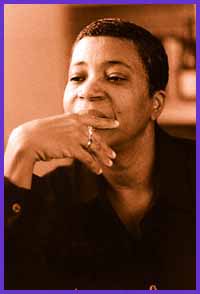On the evening of Apr 8, there is a long line-up outside the George Ignatief Theatre at the University of Toronto for a reading by Dionne Brand from her just released second novel.
The buzz outside the theatre briskly pours inside, where the excitement is almost uncontainable. Some people have to be turned away. The reading, hosted by Toronto Women’s Bookstore and Random House, is sold out. Stefanie Samuels’ introduction is a praise-song to Brand, calling her a “powerfully gentle storyteller.”
Brand arrives at the podium, telling the audience she thought “no one would show for the reading.” The laughter from the audience is filled with love. Brand then eloquently and poetically reads from At The Full And Change Of The Moon for about an hour and a half. The evening ends at 52 Inc where folks eat, drink and dance well into the night.
Land To Light On, her Governor General’s and Ontario Trillium award-winning poetry collection, has reportedly gone into its fourth printing, making Brand a best-selling poet – an unheard of category in these times.
With the publication of her second novel, there is no doubt that Brand has emerged as one of the nation’s most important writers. At The Full And Change Of The Moon is a powerfully crafted novel, evidence of how serious Brand takes the art of writing.
I sat down with Brand a few days after the book launch. Brand is at ease discussing the work. She is anxious to address its literariness yet weary of discussions verging on the sociology of her characters. She is equally bored with attempts to pigeonhole her with adjectives. Brand wants to talk about art and the making of art and she insists on doing so.
She wants us to consider the interior lives of her characters and is uninterested in readings which require her to bear the burden of representation for black people. “I am not starting from theme [or] ethnographic drawing,” she says. “I am starting from impression.” She insist that her writing be read as art.
At The Full And Change Of The Moon is about a heroic, and at the same time a horrific, act. It begins with a mass poisoning committed by a slave woman, Marie Ursule. Brand says she is “fascinated by the kind of resolve” which allowed Marie Ursule to carry out such an act. The poisoning launches us into the traumatic lusciousness of the novel’s world.
Brand says she wrote the first line of the book first. It describes the day Marie Ursule decides is the day of the mass poisoning. It is a beautiful, slow and deliberate sentence filled with awe and terror. And considering Marie Ursule, Brand says: “One would have to conceive of that day, and waking up that morning, do that thing. Those kinds of acts fascinate me.”
In any conversation with Brand, one cannot help but notice her fascination with the imagination. “Imagination is long and open, and you are always guided by your imagination,” she says. “Outside of the other places we live, we live on imagination.”
And it is imagination and “small impressions” which populate the narrative of At The Full And Change Of The Moon. They range from watching men hustling in Amsterdam, to sentence fragments from memoirs and history texts, to a note on the wall of a museum in Trinidad. These impressions are reimagined by Brand as she weaves a narrative in which, through the traumas of history, pain and suffering offer insights into what it means to be human. Brand says she’s motivated by watching “people just living life.”
Brand is relaxed and poised. Her weariness and reluctance to be slotted into sociological and political categories which some think are immediately self-explanatory is admirable. By insisting on the literariness of her writing, Brand implicitly puts out a different kind of challenge. It is a challenge to read her well and to read her within a community of writers.
So if you want to fully appreciate the experience of reading her, you might need to read Latin American, Caribbean, African, African-American and, yes, even European writers.
At least one thing is apparent from speaking with Brand about the making of art and literature, it’s her interest in the “sensuous phenomenon” of art, a phenomenon she desires and celebrates.

 Why you can trust Xtra
Why you can trust Xtra


